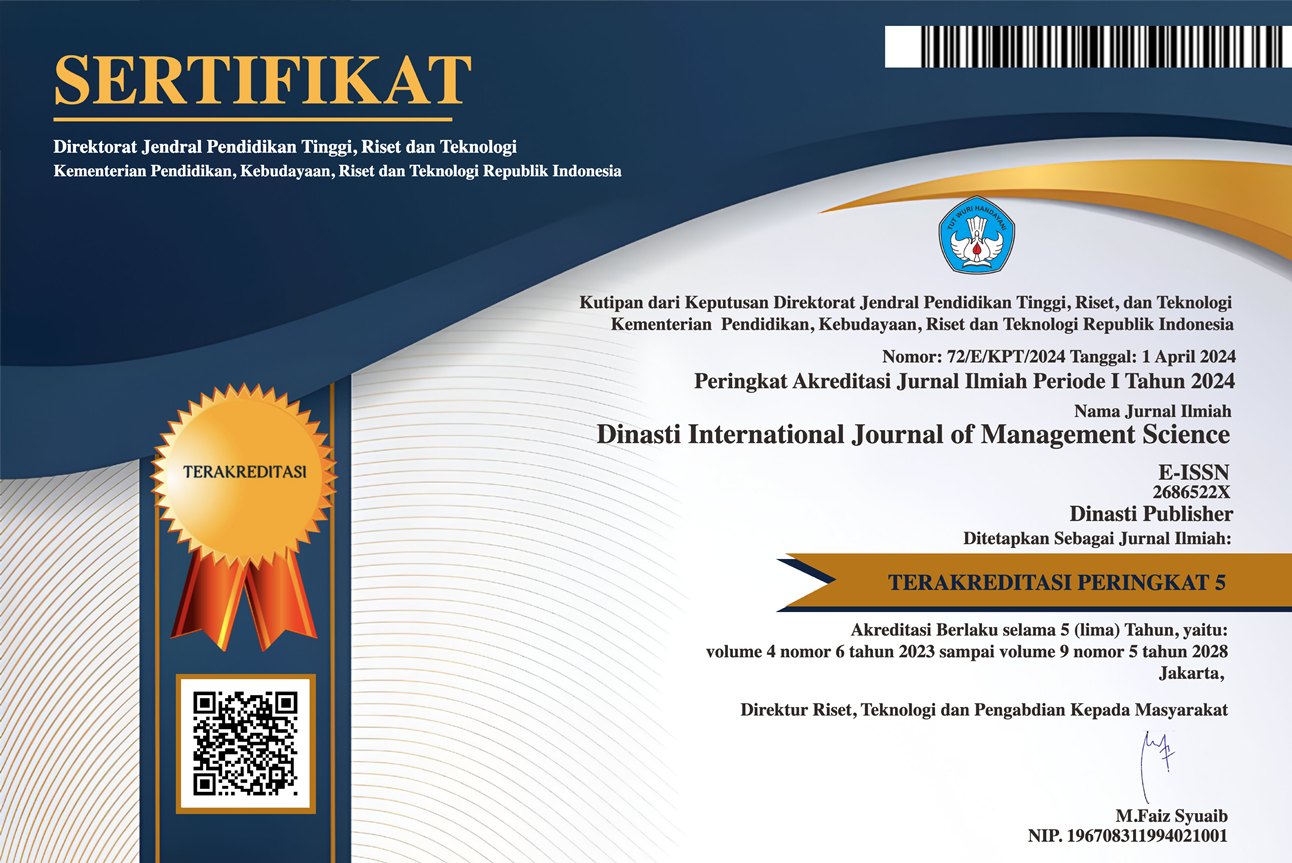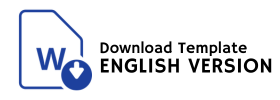Determination of Air Cargo Performance: Analysis of Revenue Management, Terminal Operations, and Aircraft Loading (Air Cargo Management Literature Review)
DOI:
https://doi.org/10.31933/dijms.v4i5.1822Keywords:
revenue management, terminal operations, aircraft loading, air cargoAbstract
Previous research or relevant research is very important in a research or scientific article. Previous research or relevant research serves to strengthen the theory and phenomena of the relationship or influence between variables. This article reviews three issues, namely: revenue management, terminal operations, and aircraft loading which affect the performance of air cargo. The results of this literature review article are: 1) There are revenue management problems that can affect air cargo performance; 2) There are problems with terminal operations that can affect the performance of air cargo; and 3) There are problems with aircraft loading which can affect the performance of air cargo.
References
Amaruchkul, K., Cooper, W. L., & Gupta, D. (2007). Single-leg air-cargo revenue management. Transp. Sci, 41(4), 457–469.
Amaruchkul, K., Cooper, W. L., & Gupta, D. (2011). A note on air-cargo capacity contracts. Prod. Oper. Manage, 20(1), 152–162.
Bae, M. . (2011). The Study on Airline Choice Factors of Air Freight Forwarders: on the Basis of IT Products. Pusan National University (Master’s Thesis).
Bela, L., Riani, A., & Indriayu, M. (2021). Analysis Gender in Entrepreneurship Education: Role of Entrepreneurial Potential and Mindsets on Intention Students in Universities. https://doi.org/10.4108/eai.22-7-2020.2307871
Boeing. (2012). World Air Cargo Forecast 2012-2013. www.boeing.com/%0Aassets/pdf/commercial/cargo/wacf.pdf
Bombelli, A., Santos, B. F., & Tavasszy, L. (2020). Analysis of the air cargo transport network using a complex network theory perspective. Transportation Research Part E: Logistics and Transportation Review, 138(April), 101959. https://doi.org/10.1016/j.tre.2020.101959
Chang, Y. H., Yeh, C. H., & Wang, S. Y. (2007). A survey and optimization-based evaluation of development strategies for the air cargo industry. Int. J. Prod. Econ, 106(2), 550–562.
Derigs, U., Friederichs, S., & Schaer, S. (2009). A new approach for air cargo network planning. Transp. Sci, 43(3), 370–380.
Desai, J., Srivathsan, S., Lai, W. Y., Li, L., & Yu, C. (2023). An optimization-based decision support tool for air cargo loading. Computers & Industrial Engineering, 175, 108816.
Feng, B., Li, Y., & Shen, Z. J. M. (2015). Air cargo operations: Literature review and comparison with practices. Transportation Research Part C: Emerging Technologies, 56, 263–280. https://doi.org/10.1016/j.trc.2015.03.028
Ferguson, J., Kara, A. Q., Hoffman, K., & Sherry, L. (2013). Estimating domestic US airline cost of delay based on European mode. Transp. Res. Part C: Emerging Technol, 33, 311–323.
Gupta, D. (2008). Flexible carrier-forwarder contracts for air cargo business. J. Rev. Pricing Manage, 7(4), 341–356.
Hall, R. . (2001). Truck scheduling for ground to air connectivity. J. Air Transp. Manage, 7(6), 331–338.
Hellermann, R., Huchzermeier, A., & Spinler, S. (2013). Options contracts with overbooking in the air cargo industry. Decis. Sci, 44(2), 297–327.
Huang, K. C., & Chang, K. . (2010). An approximate algorithm for the two-dimensional air cargo revenue management problem. Transp. Res. Part E, 46(3), 426– 435.
Huang, K., & Lu, H. (2015). A Linear Programming-based Method for the Network Revenue Management Problem of Air Cargo. Transportation Research Procedia, 7, 459–473. https://doi.org/https://doi.org/10.1016/j.trpro.2015.06.024
IATA. (2018). IATA Cargo Strategy. IATA.
Kasilingam, R. G. (1997). Air cargo revenue management: Characteristics and complexities. European Journal of Operational Research, 96(1), 36–44. https://doi.org/10.1016/0377-2217(95)00329-0
Kim, M. . (2008). Airline Choice Factor Analysis of Air Freight Forwarders. In Inha University (Master’s thesis).
Kupfer, F., Meersman, H., Onghena, E., & Van de Voorde, E. (2016). The underlying drivers and future development of air cargo. Journal of Air Transport Management, 61, 6–14. https://doi.org/10.1016/j.jairtraman.2016.07.002
Lange, A. (2019). Does cargo matter? The impact of air cargo operations on departure on-time performance for combination carriers. Transportation Research Part A: Policy and Practice, 119(November 2018), 214–223. https://doi.org/10.1016/j.tra.2018.10.005
Lau, H. Y. K., & Zhao, Y. (2006). Joint scheduling of material handling equipment in automated air cargo terminals. Comput. Ind, 57(5), 398–411.
Lee, C., Huang, H. C., & Liu, B., Xu, Z. (2006). Development of timed Colour Petri net simulation models for air cargo terminal operations. Comput. Ind. Eng, 51, 102–110 (1-Sp. Iss. SI).
Lee, D. . (2003). A Study of Airline Choice Behavior of Air Freight Forwarders. In Korea Aerospace University (Master’s thesis).
Leung, L. C., Van Hui, Y., Wang, Y., & Chen, G. (2009). A 0–1 LP model for the integration and consolidation of air cargo shipments. Oper. Res, 57(2), 402–412.
Li, Z., Bookbinder, J. H., & Elhedhli, S. (2012). Optimal shipment decisions for an airfreight forwarder: formulation and solution methods. Transp. Res. Part C: Emerging Technol, 21, 17–30.
Lille, M., & Sparks, L. (1992). The buying behavior of air freight forwarders. Int. J. Phys. Distrib. Logist. Manag, 23(1), 14–22. https://doi.org/http://dx.doi.org/10.1108/ 09600039310025589.
Mongeau, M., & Bès, C. (2003). Optimisation of aircraft container loading. IEEE Trans. Aerospace Electron. Syst, 39(1), 140–150.
Moon, J. . (2010). A Study on Airline Selection Factors of Air Forwarders: application of Analytic Hierarchy Process. In Inha University (Master’s thesis).
Moon, S. W. (2006). The Study on Airline Selection Factors of Air Freight Agency. In Korea Aerospace University (Master’s thesis).
Nobert, Y., & Roy, J. (1998). Freight handling personnel scheduling at air cargo terminals. Transp. Sci, 32(3), 295–301.
Ou, J., Hsu, V. N., & Li, C. L. (2010). Scheduling truck arrivals at an air cargo terminal. Prod. Oper. Manage, 19(1), 83–97.
Park, Y. H., Choi, J. K., & Zhang, A. (2009). Evaluating competitiveness of air cargo express services. Transp. Res, 45(2), 321-334. https://doi.org/http://dx.doi.org/10.1016/ j.tre.2008.09.004
Petersen, J. (2007). Air freight industry – white paper. Research Report, Georgia Institute of Technology. www.scl.gatech.edu/industry/industry-studies/%0AAirFreight.pdf
Rong, A., & Grunow, M. (2009). Shift designs for freight handling personnel at air cargo terminals. Transportation Research Part E: Logistics and Transportation Review, 45(5), 725–739. https://doi.org/https://doi.org/10.1016/j.tre.2009.01.005
Tseremoglou, I., Bombelli, A., & Santos, B. F. (2022). A combined forecasting and packing model for air cargo loading: A risk-averse framework. Transportation Research Part E: Logistics and Transportation Review, 158, 102579. https://doi.org/https://doi.org/10.1016/j.tre.2021.102579
Turkish Cargo. (2017). 2010’dan Beri En Güçlü Büyüme. Turkish Cargo Magazine S, 32–33.
Wasesa, M., Rahman, M. N., Rizaldi, A., & Mashuri. (2015). Relocating a Multiple-tenants Logistics Center: Lesson Learned from an Air Cargo Terminal Relocation Project. Procedia Manufacturing, 4, 139–145. https://doi.org/https://doi.org/10.1016/j.promfg.2015.11.024
Wong, W. H., Zhang, A. M., Van Hui, Y., & Leung, L. C. (2009). Optimal baggage-limit policy: airline passenger and cargo allocation. Transp. Sci, 43(3), 355–369.
Xu, D., Zhang, C. W., Miao, Z., & Cheung, R. K. (2014). A flow allocation strategy for routing over multiple flow classes with an application to air cargo terminals. Comput. Oper. Res, 51, 1–10.
Yan, S., & Chen, C. H. (2008). Optimal flight scheduling models for cargo airlines under alliances. J. Scheduling, 11(3), 175–186.
Yan, S., Chen, C. H., & Chen, C. . (2006). Long-term manpower supply planning for air cargo terminals. J. Air Transp. Manage, 12(4), 175–181.
Yoon, S. H., & Park, J. W. (2015). A study of the competitiveness of airline cargo services departing from Korea: Focusing on the main export routes. Journal of Air Transport Management, 42, 232–238. https://doi.org/10.1016/j.jairtraman.2014.11.004
Downloads
Published
How to Cite
Issue
Section
License
Authors who publish their manuscripts in this journal agree to the following conditions:
- The copyright on each article belongs to the author(s).
- The author acknowledges that the Dinasti International Journal of Management Science (DIJMS) has the right to be the first to publish with a Creative Commons Attribution 4.0 International license (Attribution 4.0 International (CC BY 4.0).
- Authors can submit articles separately, arrange for the non-exclusive distribution of manuscripts that have been published in this journal into other versions (e.g., sent to the author's institutional repository, publication into books, etc.), by acknowledging that the manuscript has been published for the first time in the Dinasti International Journal of Management Science (DIJMS).
















































